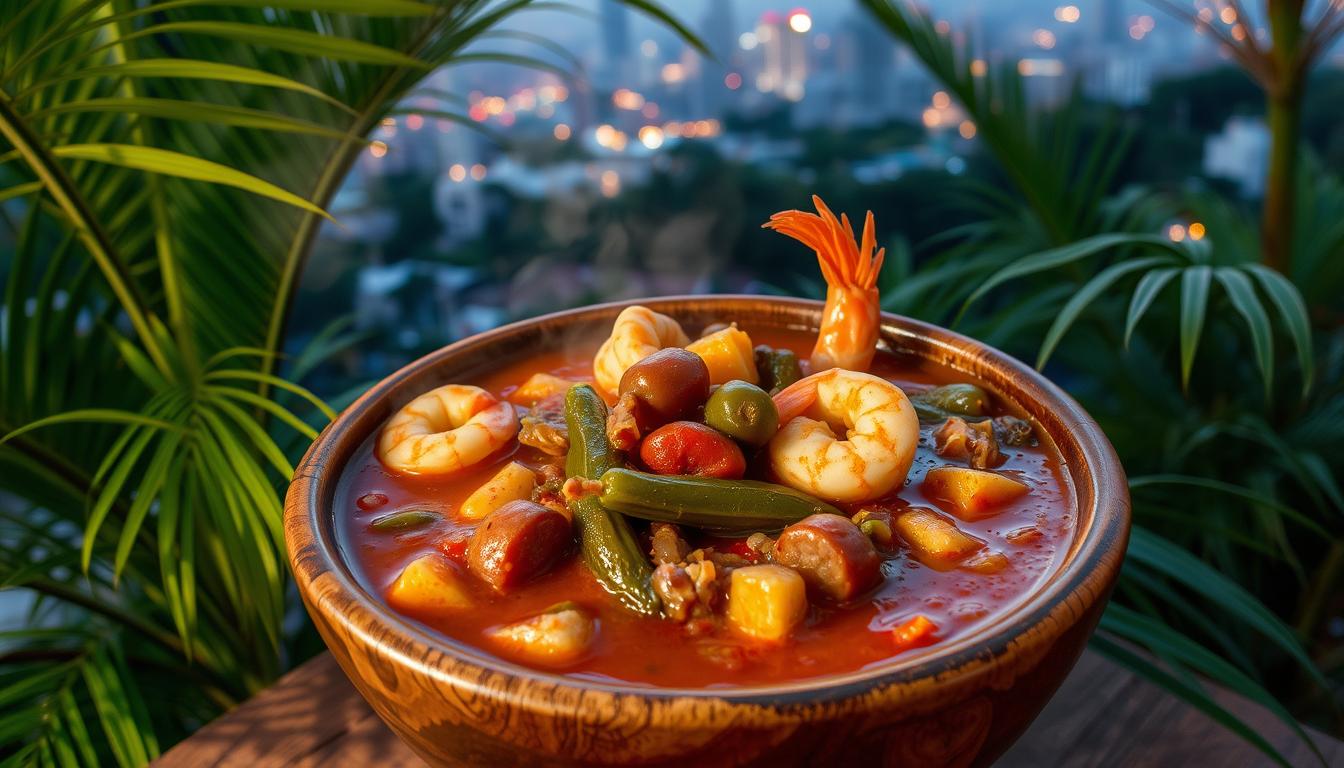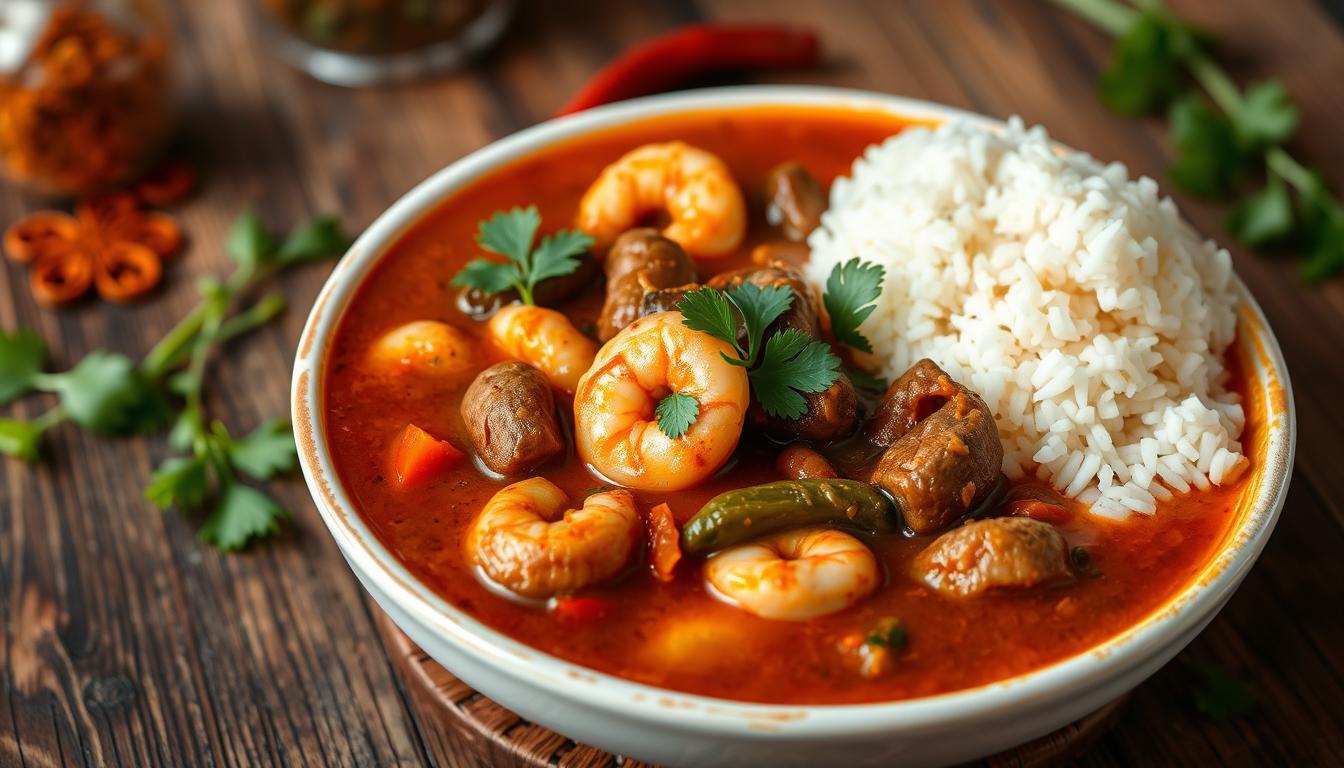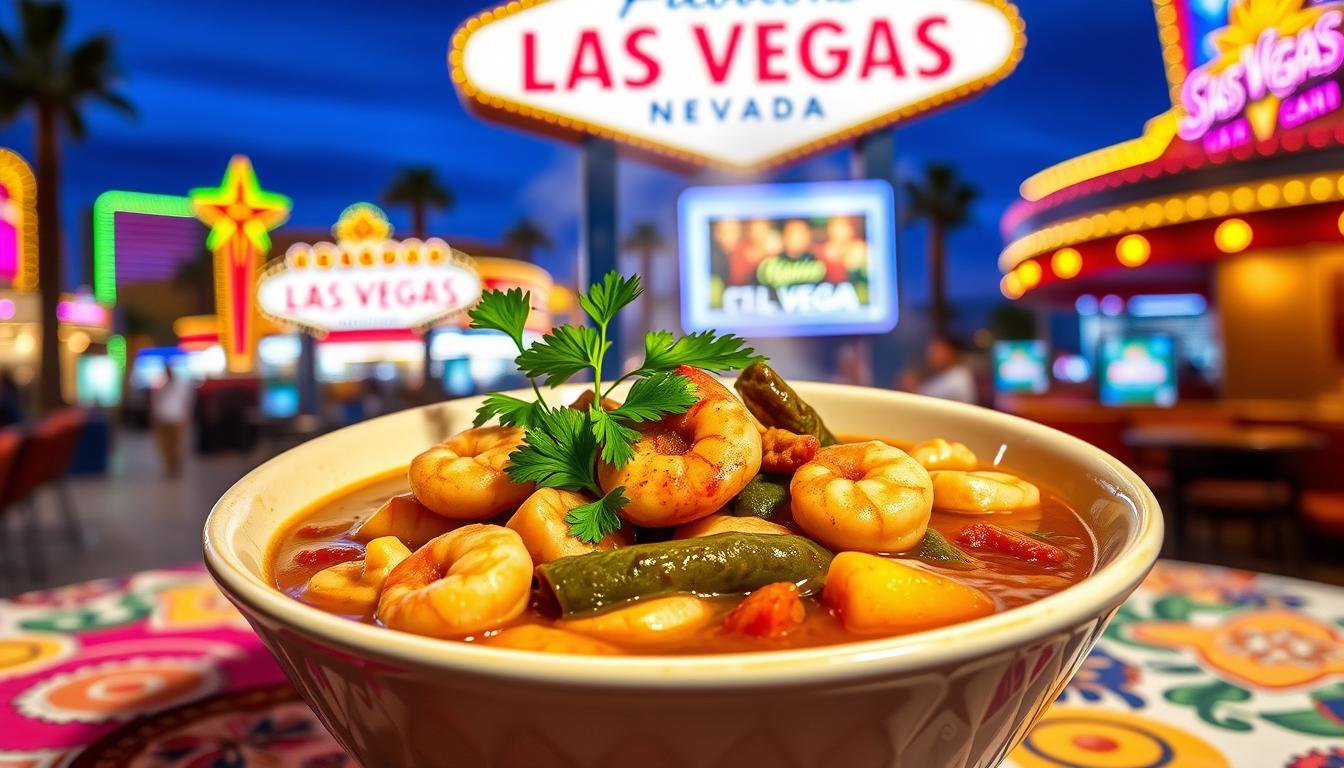Did you know that about 65% of gumbo recipes use shrimp as a main ingredient? This dish, full of history and taste, has become a favorite in many places, including Refugio. In this guide, you’ll learn more than just how to make a great gumbo. You’ll also discover its origins, the key ingredients, and cooking tips to improve your skills.
Whether you’re an experienced chef or just starting out, this guide will help you make this iconic dish at home. You’ll learn about picking the right spices and finding local twists. Each part is made to improve your cooking journey into the world of Refugio gumbo.
Introduction to Gumbo and Its Origins
Gumbo, a dish from Louisiana, is a mix of many cultures. It comes from African, French, and Native American traditions. This blend shows the history of the South and its cultural mix.
The gumbo history starts in the 18th century. It began as a simple stew but became a symbol of Southern hospitality. Gumbo is more than food; it’s a time for families and friends to come together. It strengthens bonds and shares stories, showing its cultural significance.
Gumbo’s ingredients come from different cultures. Okra and African rice are key, showing the impact of various cultures. Making gumbo is a way to unite people. It teaches about history, identity, and connection through food.
| Cultural Influence | Contributions | Impact on Gumbo |
|---|---|---|
| African | Okra, African rice | Enhanced texture and flavor |
| French | Rouxs, spices | Depth of flavor and richness |
| Native American | Indigenous vegetables | Local adaptation of ingredients |
Gumbo has become popular across the country. Its story shows how cultures talk to each other through food. It’s a dish that tells a story of shared experiences and histories.
Understanding the Core Ingredients of Authentic Gumbo
Every bowl of authentic gumbo is a celebration of flavor. It’s built on a foundation of carefully selected ingredients. The roux, made from flour and fat, is cooked until it’s deep brown. This adds thickness and a rich, nutty flavor that’s key to the gumbo’s taste.
The Holy Trinity is another important element. It includes onions, bell peppers, and celery. These ingredients form the base of many Cajun and Creole recipes. They enhance flavors, making the dish even better.
Variety in proteins adds complexity to gumbo. You can use andouille sausage, shrimp, and chicken. Each adds its own flavor and texture. Okra or filé powder thickens the gumbo, making it creamy and adding depth.
How to Prepare the Best Gumbo in Refugio
Making the perfect gumbo needs skill and knowledge of cooking techniques. These tips will guide you in preparing the best gumbo. Focus on key cooking methods and picking the right spices and seasonings to boost flavor.
Essential Cooking Techniques for Gumbo
Creating a rich, dark roux is key in gumbo cooking. Start by mixing equal parts of oil and flour over medium heat. Stir constantly until it turns chocolate-brown. This step can take 15-30 minutes, but it’s worth the wait for the flavor.
Layering flavors is also important. Begin by sautéing the “Holy Trinity” (onion, bell pepper, and celery) in the roux. Then add garlic and tomatoes. Use top-quality stock and add proteins like andouille sausage or shrimp at the right time.
You can cook the gumbo stovetop for a quick meal or in a slow cooker for a long, comforting simmer. Adjust cooking time based on your method, letting flavors blend well.
Choosing the Right Spices and Seasonings
For those new to gumbo, knowing the right spices and seasonings is key. Classic choices include:
- Cayenne Pepper – Adds heat
- Thyme – Enhances earthiness
- Bay Leaves – Contributes aroma and depth
- Black Pepper – Balances flavors
- Paprika – Provides a subtle smokiness
Add these spices gradually, tasting and adjusting as needed. Each spice adds something special to your gumbo. Aim for a balance that suits your taste while staying true to tradition.
Refugio’s Unique Twist on Traditional Gumbo
In Refugio, chefs and home cooks show off their creativity with gumbo. They mix traditional recipes with local ingredients. For example, seafood gumbo uses fresh Gulf Coast shrimp, adding a special flavor.
The rise of vegetarian gumbo is also exciting. It highlights seasonal vegetables, appealing to more people. This way, local produce gets to shine all year round.
Here are some notable Refugio gumbo variations you might find:
- Seafood gumbo with shrimp and crab
- Vegetarian gumbo featuring okra, bell peppers, and corn
- Chicken and sausage gumbo using locally sourced proteins
- Spicy gumbo that incorporates regional hot peppers
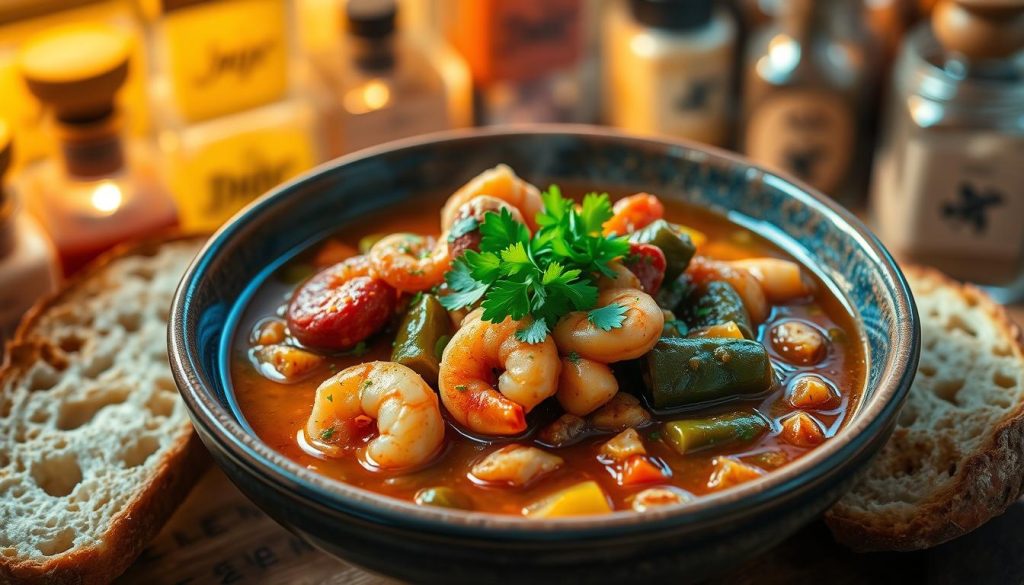
Refugio’s food scene loves to try new things. You can make your own gumbo with local ingredients. This makes your dish unique and celebrates Refugio’s rich agricultural heritage.
Finding the Top Gumbo Spot in Refugio
Refugio is a treasure trove for gumbo lovers. It’s home to local favorites and hidden gems. Each spot has its own charm and character. Customer reviews highlight what makes these places special, like their atmosphere and signature dishes.
Local Favorites: Best Gumbo Restaurants in Refugio
Several restaurants in Refugio are top contenders for the best gumbo spot. Sluurpy has aggregated 14 restaurant menus in Refugio. The ranking is based on user recommendations in the last month. Here are some top picks:
| Restaurant Name | Specialty Dish | Pricing | User Recommendations |
|---|---|---|---|
| Raul’s Place | Raul Special | $11.99 | High |
| Gumbo Haven | Cup of Gumbo | $12.00 | Moderate |
| Taco Spot | Frequent mention for tacos and service |
What Makes Refugio Gumbo Stand Out
Refugio’s gumbo is special. Customers love the large portion sizes, which offer great value. They also praise the fast service and homemade quality, like the tortillas.
The atmosphere is welcoming, thanks to friendly service. This makes diners feel at home. Refugio’s gumbo scene is a mix of great dining and quality food. Try these local favorites to explore a world of flavors. Enjoy the unique gumbo that shows the community’s heart and soul.
Tips for Perfecting Your Gumbo Recipe
Making the perfect gumbo takes practice and attention to detail. Follow these tips to improve your dish and get delicious results every time. Knowing common mistakes can also help avoid culinary disasters. Learn how to customize gumbo for different tastes and dietary needs, so everyone can enjoy it.
Common Mistakes to Avoid When Making Gumbo
Creating a flawless gumbo can be tricky. Avoid overcooking the roux to prevent a bitter taste. Also, don’t underestimate the importance of spices, as too little can make the gumbo taste bland. Let your ingredients simmer long enough to release their flavors.
Don’t overlook the importance of layering flavors. This is what gives gumbo its rich taste. Pay attention to these details to avoid common mistakes.
How to Customize Your Gumbo for Different Tastes
Customizing gumbo opens up a world of possibilities in the kitchen. You can choose your protein, like shrimp, chicken, or sausage. Vegetarians can use legumes instead of meat.
Adjust the spice levels to your liking by trying different hot sauces or peppers. Add fresh seasonal vegetables to give it a twist. With these ideas, you can make gumbo that suits any occasion or personal taste.
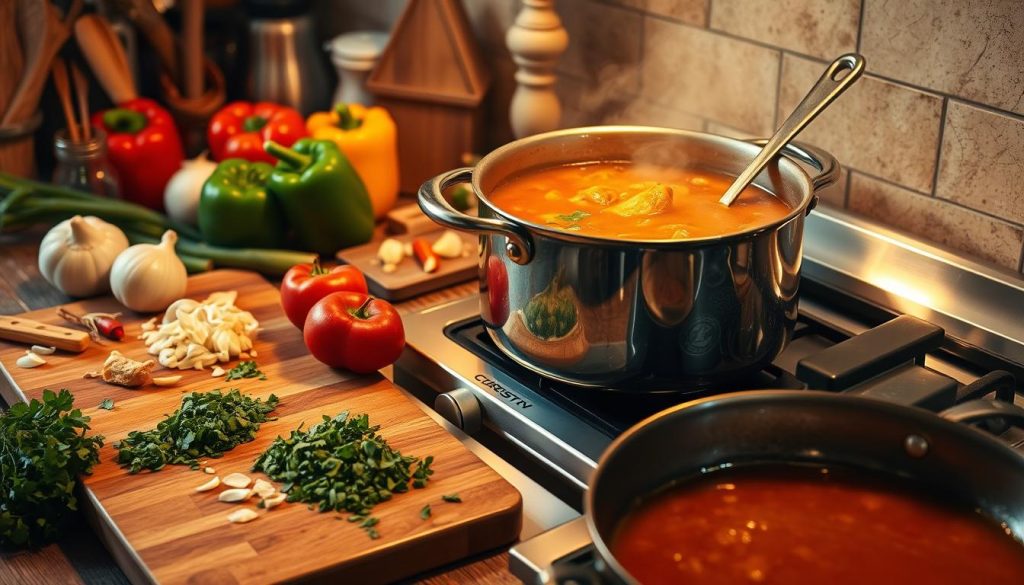
Celebrating Gumbo: Community Events in Refugio
The spirit of Refugio comes alive at its gumbo festival. This annual event brings together gumbo fans from everywhere. It’s more than food; it’s about celebrating culture, talent, and community.
At these events, you’ll find cooking contests, tastings, and live music. People from different places share their gumbo recipes. It’s a chance to try new flavors and join in the fun.
Want to know what to expect at the gumbo festival Refugio? Here’s a quick guide:
| Event Name | Date | Location | Activities |
|---|---|---|---|
| Annual Gumbo Cook-Off | March 15 | Downtown Refugio | Cooking competition, tastings |
| Gumbo Tasting Party | March 16 | Refugio Park | Sample different styles, live music |
| Family Gumbo Fun Day | March 17 | Community Center | Kids’ activities, cooking demos |
These events are great for families and friends to enjoy together. They help us appreciate Refugio’s food and traditions. Join the gumbo celebration this year and make memories with delicious food and fun.
Conclusion
Exploring gumbo in Refugio shows it’s more than a meal; it’s a cultural treasure. This guide has covered its origins, key ingredients, and tasty recipes. Now, you’re ready to make your own gumbo, armed with helpful tips and techniques.
Next, dive into the local gumbo scene. Visit restaurants to see their unique gumbo styles. Each place adds its own twist, deepening your love for this dish.
Gumbo is a way to bond with loved ones and celebrate Southern cooking. Use the resources given to improve your cooking. Share your gumbo with others and add your own flair to every dish.
Source Links
- Austin American-Statesman Sitemap: August 28, 2016
- Homework assignment #8 | Computer Science homework help
- The Gradual Loss of African Indigenous Vegetables in Tropical America: A Review
- Food Timeline–Mexican and TexMex food history
- untitled
- Americas Best Value Inn Refugio
- tde Gumbo Seafood, Refugio – 50 Reviews, menu and Photos – food74.com
- ‘E SVN: raster trunk/illume/dicts’ – MARC
- The best restaurants in United States with menus (updated in January 2025) – Sluurpy
- Bluewater Grill Shines in Lighthouse
- The Gumbo Seafood – Cyrus Ramsey
- News Headlines – Center Broadcasting Live – Local – Reaching Out
